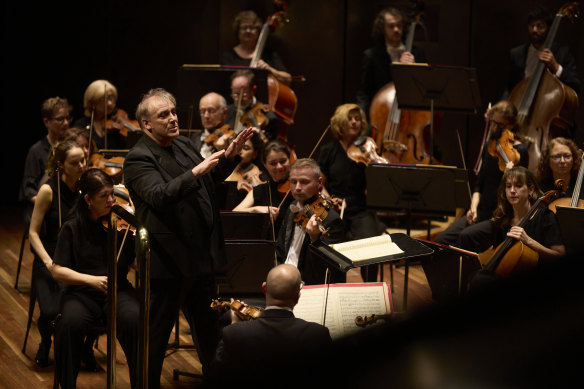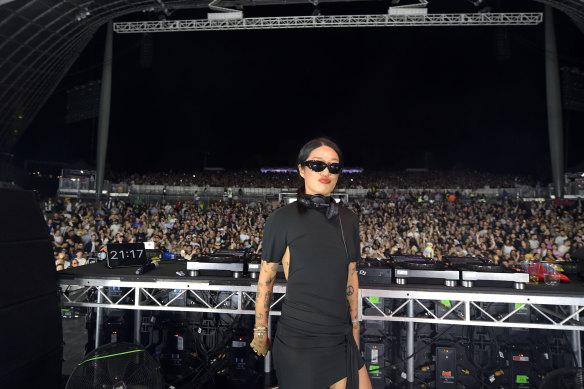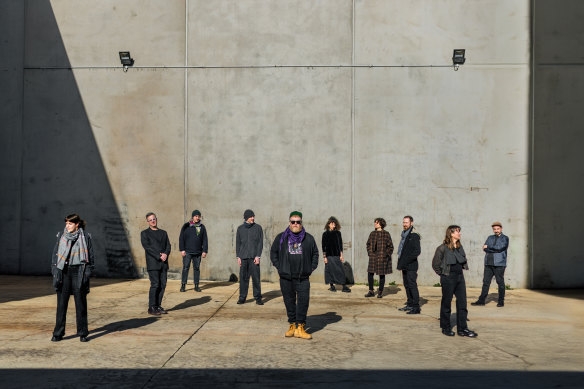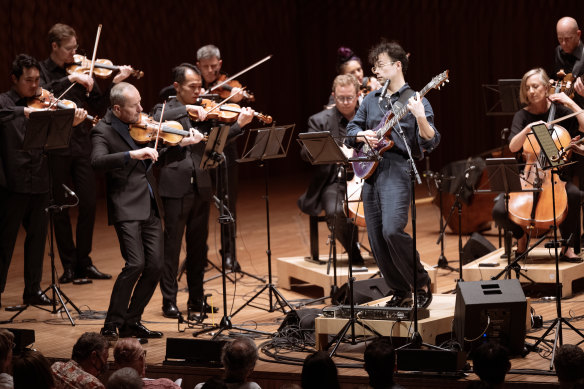
A chaotic blend of off-the-wall tangents and genuine poignancy follows. Comic songs inspired by zombie video games, middle-aged sex and, yes, foxes brush against the melancholy optimism of The Light on the Hill from Keating! and an “emo” section that gently draws out a sense of elegy from under the razzle and the dazzle.
There’s a loveliness, an unaffected sensitivity to McLeish’s folk tenor vocals – and a seductive playfulness to both the onstage persona and the melodies, largely backed by acoustic guitar with a spot of piano, and (winningly) a whistling solo.
The fox does have a kink in its tail. One late riff with pugs in it is half-arsed, and feels like an emotional evasion too. What the show needs is a crafty climax, maybe a proper short monologue that turns into another Mono-caba-logue-a-ret – something, at any rate, that can clutch in its jaws all the passion and precarity the show skirts around with such wily, whimsical instinct.
Reviewed by Cameron Woodhead
MUSIC
Beethoven Festival: Symphonies 1 & 3 ★★★★
Melbourne Symphony Orchestra, Hamer Hall, November 19
Traversing nine symphonies in 10 days, the Melbourne Symphony Orchestra’s Beethoven Festival presents a rare opportunity to savour all the composer’s works in this genre, especially those that seldom make an appearance in the concert hall.
Tuesday’s opening concert comprised the first and third symphonies – the first developing the style of his teacher Haydn and the third being the stirring Eroica over which Napoleon Bonaparte casts a long shadow.
Chief conductor Jaime Martín clarified and reinforced musical textures by seating first and second violins facing each other from opposite sides of the stage and the double basses behind the first violins and cellos.

Jaime Martín conducts the Melbourne Symphony Orchestra in the opening performance of their Beethoven Festival. Credit: Laura Manariti
In his account of Symphony No. 1 in C, Op. 21 Martín was at pains to emphasise the music’s lightness with tightly sprung rhythmic gestures, upbeat tempos and tapered phrase ends. The phrasing worked particularly well with the winds but occasionally unfocussed intonation in the upper strings let melodic tendrils droop.
Acting as a jovial tour guide, Martín used his gestures to point out various rhythmic or instrumental features along the way. Surrounding the bustling outer movements the second-movement Andante had appealing balletic poise, while the Trio of the ensuing Menuetto allowed the excellent winds to shine.
Charming as this performance may have been, the overall effect lacked structural emphasis and seemed more like a passing parade of charming scenes.
From the very opening notes, Martín’s reading of the Eroica was an altogether more purposeful affair. Bearing the fruits of having worked with the MSO intensively for three years, this performance benefited from far more detail than his previous account with the orchestra in early 2021 before becoming chief conductor.
Loading
The first movement’s driving energy and stately melodic arches announced the huge stylistic advances Beethoven made in the four years following his first symphonic essay. In the celebrated funeral march, undergirding rhythms were carefully articulated, summoning up a mood of intense solemnity to which the ebullient scherzo was the perfect foil. Golden-toned horn playing under principal Nicolas Fleury added a true sense of occasion.
Launching directly into the finale, taken at a cracking pace, Martín not only revealed many details of Beethoven’s teeming creativity, but constructed a massive, heart-stirring climax that left no doubt as to the orchestra’s empathy and commitment to this grand musical vision.
Forthcoming concerts in this musical odyssey will no doubt see the MSO reveal more extraordinary riches from this musical Colossus.
Reviewed by Tony Way
The Beethoven Festival continues until November 30.
MUSIC
Peggy Gou ★★★★★
Sidney Myer Music Bowl, November 17
South Korean DJ Peggy Gou oozes superstar quality, and on Sunday night she transformed Sidney Myer Music bowl into an electric altar to both music and the past.
The artist – who during her career has performed across the world including at iconic nightclub Berghain in her now-home of Berlin – opened with an unanticipated intensity that set the stage for a ’90s throwback.

Peggy Gou performs at Sidney Myer Music Bowl on Sunday night.Credit: Martin Philbey
Thwacking, pumping, more beat-driven than her bright, melodic debut album, I Hear You, the opening set jumped between techno heartbeats and frenetic jungle loops, sweeping the crowd into a seemingly endless series of breathtaking, euphoric beat drops.
The set evolved, gathering texture: pulsing synth instruments, klaxons, Latin rhythm, Eurodance and numerous house mix favourites, from Masters at Work’s Work to the Morricone-sourced She’s Gone, Dance On and even the opening of Bayside Boys’ Macarena remix.

Peggy Gou oozers superstar qualities.Credit: Martin Philbey
Gou tugged us along with familiar fragments, bumps of nostalgia that made our brains fizz and turned us into a writhing carpet of dancers. The few album hits she dropped she played like a rock star, pulling back during (It Goes Like) Nanana to hear us chant.
It sounds messy, but Gou curated with characteristic restraint. The ’90s visual cues showed similar light touch: her name floating in chrome bubble writing, an 8-bit animation, graphics of spinning CDs and Tamagotchis, even a massive confetti drop.
It’s her playful, postmodern pastiche that hits our yearning for a golden age of club electronic dance music, the fashions and flashing lights of a decade most of this crowd barely experienced. She carries performances with understated poise and power, loosening her hair before a beat drop, drawing from her mid-set cigarette with effortless chic as she leads us to euphoria.
Reviewed by Kosa Monteith
JAZZ
Australian Art Orchestra 30th Anniversary Concert ★★★★
Melbourne Recital Centre, November 15
Three decades ago, composer-pianist Paul Grabowsky envisioned a contemporary jazz orchestra that would play new, original music drawing from multiple genres and traditions. In his liner notes for the Australian Art Orchestra’s debut recording in 1994, the founding director boldly declared: “[This] orchestra is here to stay.”
Thirty years on, it’s clear that Grabowsky’s conviction was well-founded. The AAO has become one of Australia’s most admired contemporary music ensembles. Many of our finest improvising artists have passed through its ranks, under the guidance of three successive leaders. All three of them (Grabowsky, Peter Knight and the current artistic director, Aaron Choulai) took part in Friday’s memorable celebration of the AAO’s 30th anniversary.
The breadth and boldness of the orchestra’s back catalogue was on vivid display, as we heard excerpts of works spanning its rich history.
The musicians on stage, too, were hand-picked to illustrate various stages of the AAO’s evolution, with several founding members (Scott Tinkler and Adrian Sherriff) sitting alongside younger players such as Sofia Carbonara (the orchestra’s associate artist for 2024).
Grabowsky joined the ensemble to perform two pieces from that seminal 1994 work, Ringing the Bell Backwards, in a new arrangement by Eugene Ball that captured the haunted grandeur of the original recording, as mournful fragments of melody draped themselves over a fractured bolero or were swallowed by bursts of free-form chaos.

The Australian Art Orchestra ensemble.
Knight’s tenure with the orchestra was represented by his compelling 2018 work, The Plains, where minimalist motifs – rippling, repeated piano patterns, and swiftly beating pulsations – were overlaid by a hazy mirage of electronics and ethereal vocals.
We also heard several works created since Choulai took the reins last year: Carbonara’s glitchily abstract Etude for an Apple, a gorgeous arrangement of Kutcha Edwards’ Homeless (featuring Edwards’ achingly heartfelt vocals), and two wonderfully idiosyncratic compositions by Choulai himself – all signalling the optimism and sense of adventure with which the AAO looks to the future.
Reviewed by Jessica Nicholas
MUSIC
Scotland Unbound ★★★
Australian Chamber Orchestra, Hamer Hall, November 17
Kindred spirits in pursuit of pushing musical boundaries, Scottish guitarist Sean Shibe and Richard Tognetti, the artistic director of the Australian Chamber Orchestra, produced a highly eclectic Scottish offering for the orchestra’s final 2024 tour.
Shibe is a classical guitarist also interested in exploring the expressive possibilities of the electric guitar. Using the classic instrument in the first half, he delivered an atmospheric opening with a solo rendition of A Scots Tune from a 17th-century manuscript, full of haunting delicacy. Joining the orchestra, gentle celebrations of traditional Scottish folk idioms continued with James MacMillan’s From Galloway and Da Trowie Burn by Shetland fiddler Friedemann Stickle.

Guitarist Sean Shibe and the Australian Chamber Orchestra perform Scotland Unbound on November 17.Credit: Nic Walker
Ranging from the ruminative to the rambunctious, a bracket of string orchestra pieces arranged by James Crabb ran the gamut of Scottish styles, from Niel Gow’s plaintive Lament for the Death of his Second Wife to the traditional Struan Robertson’s Rant which Tognetti made famous in his soundtrack for the film Master and Commander.
An ACO co-commission, Canadian composer Cassandra Miller’s guitar concerto Chanter, written for Shibe, contained some interesting effects but walked a fine line between tedium and its intended sleep-like qualities with its multiple repetition of ideas.
Striking an entirely different mood with electric guitar in the second half, an arrangement of Julia Wolfe’s LAD, with its angry imitation of bagpipes, jolted the audience into a modernist soundscape that led to slow and fast melodies full of raw energy.
Loading
By contrast, David Fennessy’s Hirta Rounds for strings was a hushed evocation of a remote, abandoned island that cast its spell, even if it outwore its welcome by a few minutes.
Releasing both Tognetti and Shibe’s inner rock stars, selections from Martyn Bennett’s Bothy Culture, a high-energy amalgam of Celtic folk and electronic styles, brought this curious catch-all program to a rollicking end.
Reviewed by Tony Way
The Booklist is a weekly newsletter for book lovers from Jason Steger. Get it delivered every Friday.









 Add Category
Add Category